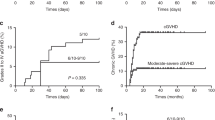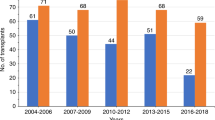Abstract
A potential link between arsenic (ATO)-based therapy and delayed hematopoietic recovery after autologous hematopoietic SCT (HSCT) for acute promyelocytic leukemia (APL) has previously been reported. We retrospectively reviewed the clinical histories of 58 patients undergoing autologous HSCT for APL at 21 institutions in the United States and Japan. Thirty-three (56%) of the patients received ATO-based therapy prior to stem cell collection. Delayed neutrophil engraftment occurred in 10 patients (17%): 9 of the 10 patients (90%) received prior ATO (representing 27% of all ATO-treated patients), compared with 1 of the 10 patients (10%) not previously treated with ATO (representing 4% of all ATO-naïve patients; P<0.001). Compared with ATO-naïve patients, ATO-treated patients experienced significantly longer times to ANC recovery (median 12 days vs 9 days, P<0.001). In multivariate analysis, the only significant independent predictor of delayed neutrophil engraftment was prior treatment with ATO (hazard ratio 4.87; P<0.001). Of the available stem cell aliquots from APL patients, the median viable post-thaw CD34+ cell recovery was significantly lower than that of cryopreserved autologous stem cell products from patients with non-APL AML. Our findings suggest that ATO exposure prior to CD34+ cell harvest has deleterious effects on hematopoietic recovery after autologous HSCT.
This is a preview of subscription content, access via your institution
Access options
Subscribe to this journal
Receive 12 print issues and online access
$259.00 per year
only $21.58 per issue
Buy this article
- Purchase on Springer Link
- Instant access to full article PDF
Prices may be subject to local taxes which are calculated during checkout



Similar content being viewed by others
References
Soignet SL, Maslak P, Wang ZG, Jhanwar S, Calleja E, Dardashti LJ et al. Complete remission after treatment of acute promyelocytic leukemia with arsenic trioxide. N Engl J Med 1998; 339: 1341–1348.
Yamamoto JF, Goodman MT . Patterns of leukemia incidence in the United States by subtype and demographic characteristics, 1997-2002. Cancer Causes Control 2008; 19: 379–390.
Sanz MA, Grimwade D, Tallman MS, Lowenberg B, Fenaux P, Estey EH et al. Management of acute promyelocytic leukemia: recommendations from an expert panel on behalf of the European LeukemiaNet. Blood 2009; 113: 1875–1891.
Sanz MA, Martin G, Gonzalez M, Leon A, Rayon C, Rivas C et al. Risk-adapted treatment of acute promyelocytic leukemia with all-trans retinoic acid and anthracycline monochemotherapy: a multicenter study by the PETHEMA Group. Blood 2004; 103: 1237–1243.
Fenauz P, Chastang C, Chevret S, Sanz M, Dombret H, Archimbaud E et al. A randomized comparison of all transretinoic acid (ATRA) followed by chemotherapy and ATRA plus chemotherapy and the role of maintenance therapy in newly diagnosed acute promyelocytic leukemia: The European APL Group. Blood 1999; 94: 1192–1200.
Lo-Coco F, Avvisati G, Vignetti M, Thiede C, Orlando SM, Iacobelli S et al. Front-line treatment of acute promyelocytic leukemia with AIDA induction followed by risk-adapted consolidation for adults younger than 61 years: Results of the AIDA-2000 trial of the GIMEMA group. Blood 2010; 116: 3171–3179.
Tallman MS, Andersen JW, Schiffer CA, Appelbaum FR, Feusner JH, Woods WG et al. All-trans retinoic acid in acute promyelocytic leukemia: long-term outcome and prognostic factor analysis from the North American Intergroup protocol. Blood 2002; 100: 4298–4302.
Adès L, Chevret S, Raffoux E, Guerci-Bresler A, Pigneux A, Vey N et al. Long-term follow-up of European APL 2000 trial, evaluating the role of cytarabine combined with ATRA and Daunorubicin in the treatment of nonelderly APL patients. Am J Hematol 2013; 88: 556–559.
Sanz MA, Lo Coco F, Martín G, Avvisati G, Rayon C, Barbui T et al. Definition of relapse risk and role of nonanthracycline drugs for consolidation in patients with acute promyelocytic leukemia: a joint study of the PETHEMA and GIMEMA cooperative groups. Blood 2000; 96: 1247–1253.
Shen ZX, Chen GQ, Ni JH, Li XS, Xiong SM, Qui QY et al. Use of arsenic trioxide (As2O3) in the treatment of acute promyelocytic leukemia (APL): II. Clinical efficacy and pharmacokinetics in relapsed patients. Blood 1997; 89: 3354–3360.
Lo-Coco F, Avvisati G, Vignetti M, Thiede C, Orlando SM, Iacobellui S et al. Retinoic acid and arsenic trioxide for acute promyelocytic leukemia. N Engl J Med 2013; 369: 111–121.
Ottaviani E, Martinelli G, Testoni N, Visani G, Tani M, Tura S . Role of autologous bone marrow transplantation as consolidation therapy in acute promyelocytic leukemia patients in complete remission. Haematologica 1998; 83: 1051–1055.
Mandelli F, Labopin M, Granena A, Irionda A, Prentice G, Bacigalupo A et al. European survey of bone marrow transplantation in acute promyelocytic leukemia (M3). Working Party on Acute Leukemia of the European Cooperative Group for Bone Marrow Transplantation (EMBT). Bone Marrow Transplant 1994; 14: 293–298.
de Botton S, Fawaz A, Chevret S, Dombret H, Thomas X, Sanz M et al. Autologous and allogeneic stem-cell transplantation as salvage treatment of acute promyelocytic leukemia initially treated with all-trans-retinoic acid: a retrospective analysis of the European acute promyelocytic leukemia group. J Clin Oncol 2005; 23: 120–126.
Linker CA, Owzar K, Powell B, Hurd D, Damon LE, Archer LE et al. Auto-SCT for AML in second remission: CALGB study 9620. Bone Marrow Transplant 2009; 44: 353–359.
Ueki T, Ohashi K, Jinta M, Okuyama Y, Hiruma K, Akiyama H et al. Delayed hematological recovery following autologous transplantation utilizing peripheral blood stem cells harvested after treatment with arsenic trioxide. Pathol Oncol Res 2008; 14: 387–390.
Yanada M, Tsuzuki M, Fujita H, Fujimaki K, Fujisawa S, Sunami K et al. Phase 2 study of arsenic trioxide followed by autologous hematopoietic cell transplantation for relapsed acute promyelocytic leukemia. Blood 2013; 121: 3095–3102.
Chen GQ, Zhu J, Shi XG, Ni JH, Zhong HJ, Si GY et al. In vitro studies on cellular and molecular mechanisms of arsenic trioxide (As2O3) in the treatment of acute promyelocytic leukemia: As2O3 induces NB4 cell apoptosis with downregulation of Bcl-2 expression and modulation of PML-RAR alpha/PML proteins. Blood 1996; 88: 1052–1061.
Evens AM, Tallman MS, Gartenhaus RB . The potential of arsenic trioxide in the treatment of malignant disease: past, present, and future. Leuk Res 2004; 28: 891–900.
Jing Y, Dai J, Chalmers-Redman RM, Tatton WG, Waxman S . Arsenic trioxide selectively induces acute promyelocytic leukemia cell apoptosis via a hydrogen peroxide-dependent pathway. Blood 1999; 94: 2102–2111.
Hayashi T, Hideshima T, Akiyama M, Richardson P, Schlossman RL, Chauhan D et al. Arsenic trioxide inhibits growth of human multiple myeloma cells in the bone marrow microenvironment. Mol Cancer Ther 2002; 1: 851–860.
Roboz GJ, Dias S, Lam G, Lane WJ, Soignet SL, Warrell RP et al. Arsenic trioxide induces dose- and time-dependent apoptosis of endothelium and may exert an antileukemic effect via inhibition of angiogenesis. Blood 2000; 96: 1525–1530.
Acknowledgements
We would like to thank Jennifer Rasmussen and Katrina De La Cruz of the UCSF Blood and Marrow Transplant Laboratory for their expert technical assistance with the CD34+ cell viability assays, and Nicole Foley and Sara Halvestine of the UCSF Division of Blood and Marrow Transplantation for their assistance with data management. This work was supported in part by an American Society of Hematology Research Training Award for Fellows (GNM), a Grant-in-Aid for Cancer Research from the Ministry of Health, Labour and Welfare of Japan (Clinical Cancer Research 23-004); and the National Cancer Center Research and Development Fund (26-A-24).
Author information
Authors and Affiliations
Corresponding author
Ethics declarations
Competing interests
The authors declare no conflict of interest.
Additional information
Supplementary Information accompanies this paper on Bone Marrow Transplantation website
Supplementary information
Rights and permissions
About this article
Cite this article
Mannis, G., Logan, A., Leavitt, A. et al. Delayed hematopoietic recovery after auto-SCT in patients receiving arsenic trioxide-based therapy for acute promyelocytic leukemia: a multi-center analysis. Bone Marrow Transplant 50, 40–44 (2015). https://doi.org/10.1038/bmt.2014.201
Received:
Revised:
Accepted:
Published:
Issue Date:
DOI: https://doi.org/10.1038/bmt.2014.201
This article is cited by
-
Effects of Arsenic Trioxide on INF-gamma Gene Expression in MRL/lpr Mice and Human Lupus
Biological Trace Element Research (2018)
-
Morphine Attenuated the Cytotoxicity Induced by Arsenic Trioxide in H9c2 Cardiomyocytes
Biological Trace Element Research (2016)
-
Autologous stem cell transplantation for adult acute leukemia in 2015: time to rethink? Present status and future prospects
Bone Marrow Transplantation (2015)
-
Acute promyelocytic leukemia: where did we start, where are we now, and the future
Blood Cancer Journal (2015)



